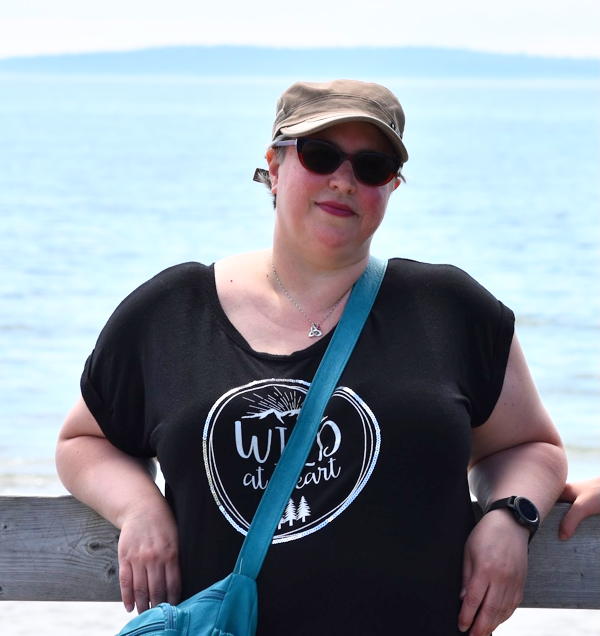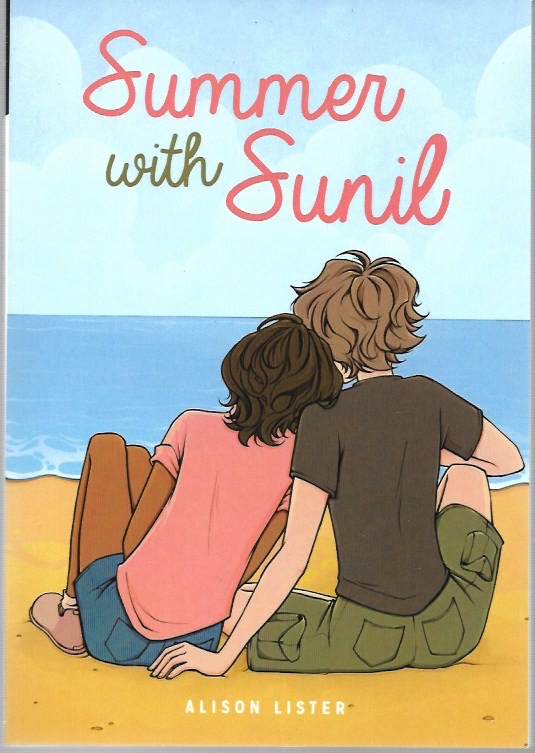Summer with Sunil is one of 20 in the Lorimer Real Love Series, a new collection of young adult novels that focus on diverse teen characters in contemporary settings who experience realistic relationships and issues.
In this novelette, Lister tells the story of two young “come from aways” who meet at a beach cottage property on the South Shore of Nova Scotia. Dominic, like any city teen arriving in small town Nova Scotia, is worried about being bored and not having his people around all summer. They soon meet Sunil, who is conveniently located in the cottage next door, having an even more isolated experience. They have a very earnest and innocent courtship and enjoy each other’s company, gaming and touring around well-known tourist destinations.
The story tackles several important themes: coming of age, contrasting different family support relationships, and dating as a trans teen. While Dominic is trans and fully supported by their family, Sunil has a different relationship with their father that starts as lack of support and tends towards neglect.
The story tackles several important themes: coming of age, contrasting different family support relationships, and dating as a trans teen.
Reading a book written for a much younger target demographic as a 44-year-old woman prompted reflections on how powerful something like this would have been for me when I was younger. I was raised in a very rural town with limited exposure to ideas outside of the templated local norm. I was too scared and unable to safely explore my identity until I left home. Then I didn’t even know where to begin. This meant a difficult, scary and isolating youth experience. One I was saved from by keeping my nose in a book, the refuge and escape I needed.
I’m so grateful this series exists for the simple fact that one day a young person may read this book and know they are not alone in this world, even if the other is a character. This is why books that provide diverse identities and perspectives are so powerful and, in some cases, lifesaving.
I expressed this gratitude to the author and they graciously agreed to answer a few questions about the writing process.

What made you interested in the Lorimer Real Love Series?
It was the opportunity to try something different, to be honest. I’ve written erotic, adult,
queer romance since 2011 and been published with small presses based in the USA
and the UK. So, to work with a Canadian publisher who actively sought me out was a
wonderful opportunity. And I feel like the more queer stories that are told, the better.
Why did you set the book in Nova Scotia?
My mom was born in Liverpool, on the south shore, and we used to drive up, our family
of six (I have two brothers and a sister), and spend summers with my Nanny and
Grampy in their little house on Summer Street. I always thought it was special that they
lived on that street since I was only there in the summertime. I fell in love with
Summerville Beach and the town of Liverpool during idyllic childhood vacations that I
think back on very fondly. I had always wanted to set a book there, and one that my
relatives might actually read (aka, not erotic/adult) so this seemed like a good chance.
The first book I wrote for Lorimer, No Limit On Love, was set in Ottawa, which is where I
live and one of my favourite settings for my books. But Summer with Sunil, which
started out with the working title of ‘Out to Sea’, was set there deliberately as an
homage to those childhood vacations.
I was able to take my own kids to Liverpool in 2019 which was a dream come true, and
they loved it and keep asking to go back.
I’m always terrified of writing characters that don’t share my lived experience
(other cultures, gender identities, race, etc) that I might unintentionally offend.
Not to make any assumptions of your own lived experience, your bio lists you as
enby, do you have a process to capture a character of a different gender identity
or cultural background than your own?
It is a daunting thing to do, and I can only say that I try to do it as well as I can. I find
that in Canada, there are so many different cultures and ethnicities, but in a lot of ways
everyone is the same. When I watch the Canadian news, there are
presenters/anchors/reporters of all different ethnicities with a diverse and incredible
variety of names, but we are all Canadian.
When I write diverse secondary characters, I try to make them like the people I know in my neighborhood and whom I’ve grown up with.
What do you hope young readers will take away from reading this novelette? (I carefully did not just say queer readers)
I hope that queer readers will see themselves and feel validated. And I h ope that non-queer readers will understand queerness a bit more, and that it will demystify it for them, you know? We’re not scary people. We’re pretty amazing, actually.
ope that non-queer readers will understand queerness a bit more, and that it will demystify it for them, you know? We’re not scary people. We’re pretty amazing, actually.
Allison Lister: "Here's a photo from the whale watching trip that inspired that section of the story."
I really reflected on the contrast of families of the two young protagonists. Was it an intentional choice to have the contrast of an accepting and supportive family vs a less supportive family? If so, what was it?
So a lot of writing about queer people has, legitimately, been about the hardship of being queer, and how so many queer people are misunderstood or not supported. In my adult fiction, the question of queerness is not even up for debate. My characters are queer and going about rewarding lives and finding sex and love. There may be instances where they have to check their surroundings before they express affection, but there is deliberately very little trouble because of their queerness.
a character faces a dire circumstance because of their queer identity, and I believe that truly reflects what might have happened in those days
It’s only in Return to Telegraph Creek, the third book in my western historical series,
Northern Horizons, that a character faces a dire circumstance because of their queer identity, and I believe that truly reflects what might have happened in those days, to someone who was living as a gender that was different than their physical appearance. But even in that situation, the transgender character comes out well in the end and triumphs over adversity.
I like to focus on the positive aspects of queerness and the joy of knowing who you are and living your life the way you are called to. There are absolutely queer kids with very supportive families these days, and I wanted to represent those stories.
Then again, there are folks who don’t take parenting seriously, like Sunil’s father.
Your work crosses different audiences and themes. What’s the most interesting thing about writing young adult fiction?
I guess it’s trying to go back to a time in my life when I was trying to figure myself out, and felt so different and not in the right body, when there weren’t even the words to express that. In a way I’m glad the labels weren’t there, as I learned to simply be myself and not dwell on any kind of definition for the way I felt. Although it has been nice to be able to apply a non-binary, trans-masc label to my identity, I sometimes think that words also limit the expression of our true and dynamic selves.
We are in a time of great political tension and we see a growing movement to erase queer communities and erase historical references to racialized and otherminority groups. Have you reflected on the potential that instead of being promoted as inclusive content we are so desperate for on the shelves of schools and libraries across North America (and further), that we are actually in a time that your book could end up on a ban or burn list?
When my first Lorimer Real Love book came out (No Limit On Love), I donated a copy to my child’s high school and it was very well received by the librarian. A teacher even invited me to speak to her class about it. When I met the librarian at the school, she apologized and said that the copy she had put in the library had disappeared. Now it could have been snatched by someone that really wanted to keep a copy, or it could have been taken by someone who didn’t think it should be there.
I had brought copies of the book for my presentation, so I smiled and gave her two more. Tada. Which is the only way you can approach these things sometimes. Just keep putting our stories out there.
It’s really unfortunate to see this growing movement that is based on ignorance and fear, and a general misunderstanding of queer people. For instance, this issue of transgender individuals and washrooms. Believe me, all that a trans person wants to do in the washroom is use the toilet. They aren’t out on some evil mission, like some people seem to believe. I understand that gender diversity challenges established norms and gender roles that have a basis in the patriarchy and the hierarchy of our society, so of course the people who benefit from the power they get from the status quo are going to protest. But we’ve been moving forward so much and it’s such a shame that things seem to be devolving in such a startling way.
Summer With Sunil is available anywhere you buy books, from the Lorimer website, or can be ordered via Amazon, Local Bookstores, or Indigo.

 Review & Interview by Wendy Walters • Halifax • 2025-05-16
Review & Interview by Wendy Walters • Halifax • 2025-05-16